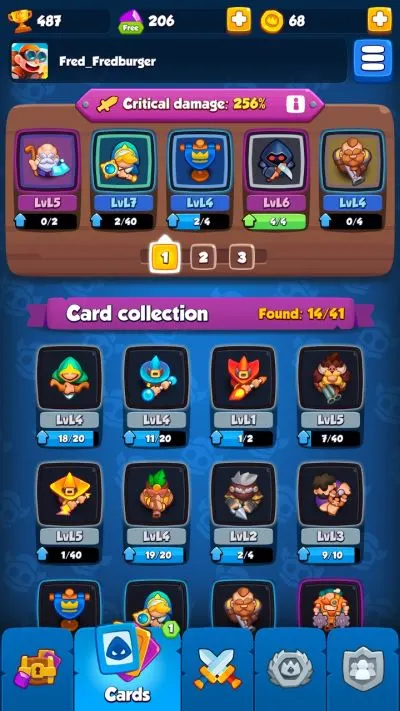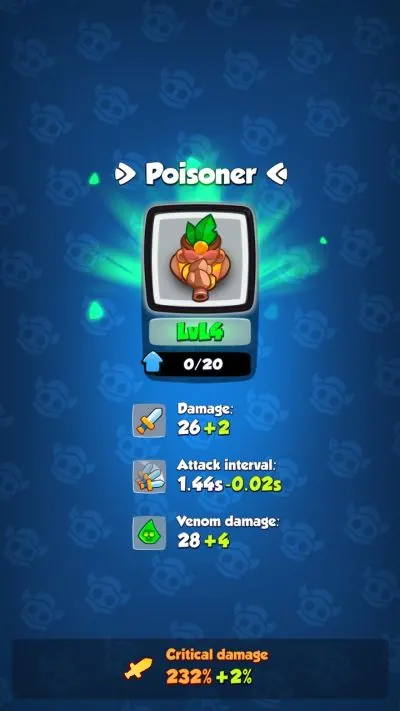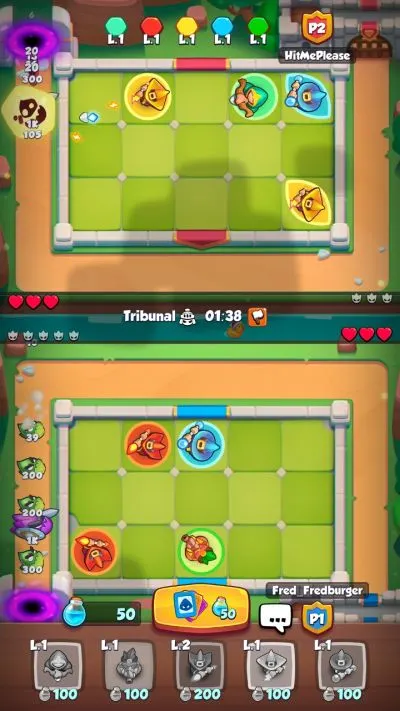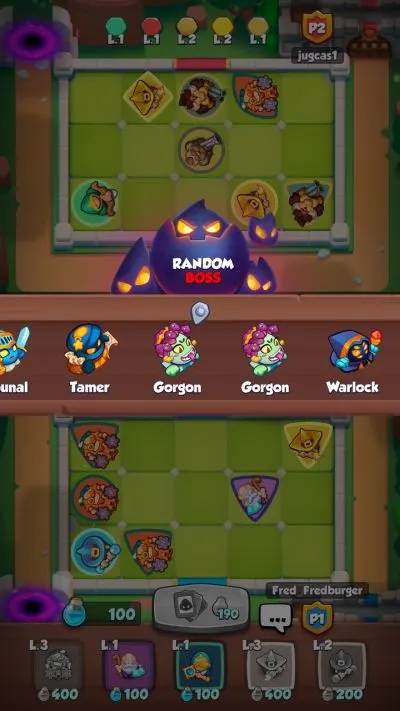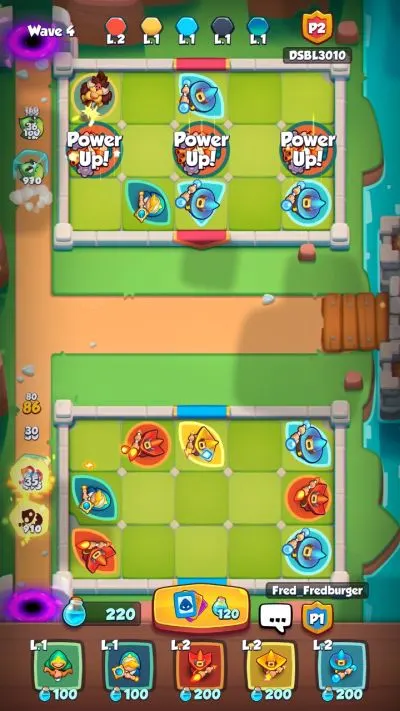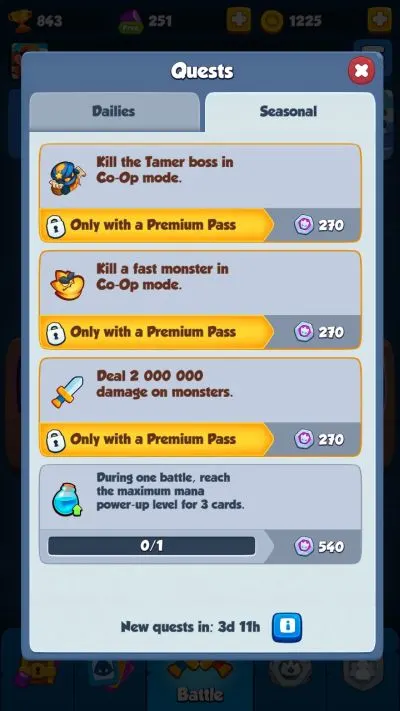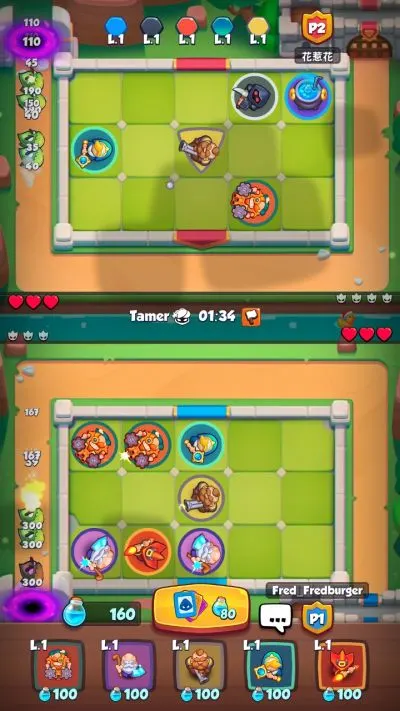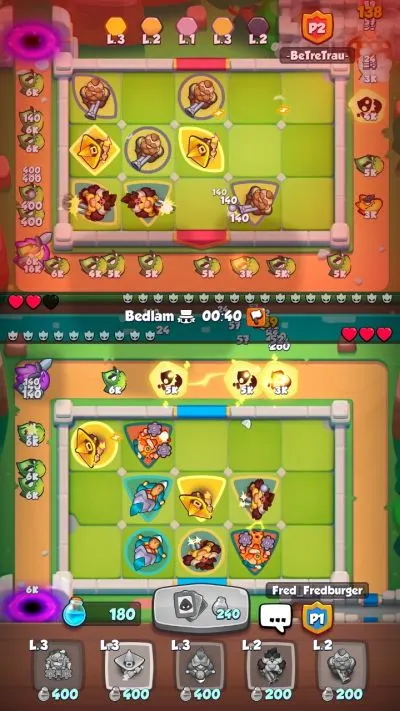Rush Royale is a mobile fantasy tower defense game developed by IT Territory and published by My.Games where you assemble your defenders to kill incoming monsters, while making sure your opponent does not survive their own siege. Alternatively, you can team up with another player to see how long you two can hold the line against the enemy.
Though this game comes with a tutorial, our Rush Royale beginner’s guide will also teach you the basics of both PvP and Co-op game modes, some of your available defenders, and what you will be up against. So without further ado, let’s dive into our detailed Rush Royale guide for some useful tips, tricks and strategies to dominate your opponents!
1. Understand The Gameplay Basics
At the start of every match, both players have a 3×5 grid to place their units and start with 100 units of mana each. Mana is used to summon your starting forces and this is located at the lower half of your screen. The units you summon are at random based on your loadout, as is their placement on the grid.
To compensate for the lack of space, you can merge two identical units by dragging one unit to another, creating a new, albeit random unit with improved fire rate. The selected units must also be of the same merge rank, which is indicated by the border around any given unit on the grid. A circle indicates a Rank 1 unit, a pointed oval indicates a Rank 2 unit, a triangle indicates a Rank 3 unit, and so on.
However, there is one drawback with merging: the overall power of the merged unit is based on their rank. This can result in damage losses when merging high-ranking units. For example, you have a pair of Rank 2 units that have 200 power each for a total of 400 power. Merging them results in a single Rank 3 unit that only has 300 power, losing 100 power from the merge. Getting too enthusiastic with merging may result in your defenses being overwhelmed.
Related: Rush Royale Tier List: A Complete Look at the Best Units in the Game
Mana is acquired primarily by killing enemies, and is used to summon new units and upgrade existing ones. The cost of summoning new units increases with every use, even if you have fewer units than before, so be mindful about acquiring extra firepower. You may also upgrade a given group of units by selecting their icon at the bottom of the screen. This will apply to both preexisting units as well as future additions. Units can be upgrades four times per match, with mana costs doubling each time.
2. Knowing And Managing Your Defenders
Although you can only bring up to five defender types in any given match, the game gives you three loadout slots to customize your defender compositions. After completing the tutorial, you’re given the following five defenders to start with:
Archer: has the fastest attack speed of your starting towers; will most likely be your initial source of DPS
Cold Mage: slows down whoever he targets, with the speed debuff stacking with every hit
Fire Mage: deals damage in an area of effect around his target
Lightning Mage: his attacks jump to the closest three targets, with damage decreasing with each jump
Poisoner: deals damage over time, but has the slowest attack speed of your starting units
Winning matches awards two to three rewards: coins as your primary currency, tokens to earn additional awards based on the current season, and arena rank points exclusively from PvP, which is where you unlock new units along with sizeable rank up bonuses. You may also choose to watch an ad before starting a match, which increases your potential rewards (except arena rank points) and a small amount of crystals, the game’s premium currency. Arena rank also determines the level of your opponent in PvP matches to keep things balanced.
Defenders are sorted into cards, with their rarity indicating how powerful they are. New cards are acquired by purchasing them at the shop with coins or via potential drops from chests you can get as rewards throughout the game. Duplicate cards of a given defender are used to level them up and improve their stats, spending both the duplicates and an increasing sum of coins for each upgrade, and rarer units require more coins to level them up. Leveling up units this way also increases your critical damage multiplier. This applies to all your collected units, giving some incentive on upgrading units you are not too fond of using.
However, not every defender is designed for direct combat. Some units specialize in buffing your forces or managing unit placement over attacking enemies, while others are designed to cripple your opponent directly. Here’s a sample of some of the defenders you can unlock and use as you progress throughout the game:
Priestess: grants you bonus mana when she is merged or killed
Reaper: has a small chance of instantly killing their target, provided it is not a boss
Engineer: gets a shared, stackable damage boost for every Engineer he is connected to, horizontally or vertically
Sharpshooter: deals increased damage to bosses and minibosses and focuses on targets with the most health
Portal Keeper: can swap places with another unit of the same rank, making him very helpful with managing unit placement
Banner: deals no damage, but increases the attack speed of units adjacent to it
Bombardier: shots have a small chance of stunning his targets and disrupting their abilities
Mime: can merge with any unit of the same rank
3. Preparing For PvP Matches
In PvP matches, monsters will spawn from the left side of your screen, travel on a lane that wraps around your grid, and try to enter your castle from the right side. It is up to your defenses, and a fair bit of luck with their placement and merge results, to defeat the invaders. You and your opponent have three lives each, and the match ends when someone loses all their lives first or chooses to forfeit.
Monsters will spawn at a steady rate for both players, but any monster you kill will immediately respawn on the opponent’s side of the arena and vice versa. Monsters come in three flavors: standard green monsters that make up the majority of attackers (including those sent to the other side of the board), yellow monsters that move fast but have low health, and purple miniboss monsters that have more health and eat up two lives instead of just one, but move slowly.
PvP rounds last for two minutes and begin by selecting a random boss. Once those two minutes are up and neither player has lost the match, the boss will spawn, gaining additional health for every enemy still alive on your side of the arena. Besides the large amount of health they have, all bosses are capable of impairing your grid as they travel, and take two lives just like the minibosses.
Mercifully, only the boss will spawn during that round, with one exception, and reward a sizeable amount of mana when they die. Here is a list of the bosses you may encounter, as well as their behaviors:
Tribunal: equalizes both your grids by destroying select units, and periodically dashes as he travels, negating any slowing effects
Warlock: summons a meteor to destroy a random unit, purges any debuffs he might have on him, and heals himself in that order, repeating the sequence until he is dealt with
Gorgon: periodically petrifies a pair of protectors, gradually reducing the damage your grid can deal until you defeat her; adjacency bonuses are unaffected and she has no means of dispelling debuffs
Tamer: occasionally summons a bunch of monsters to distract your units while he continues to move untargeted but otherwise has no special abilities; the monsters he summons do not reward mana
Bedlam: randomizes your units based on your loadout every few seconds, keeping your previous units’ ranks
Should both players survive the boss round, a new round begins with another random boss, with monster and boss health increasing each time until someone loses. It is worth noting that once you reach a certain arena rank, PvP losses will incur a small rank penalty that decreases your arena rank progress, but does not penalize you outside of the arena rank of your future opponents. However, winning a match will more than cover for that loss unless you’re on a severe losing streak.
4. You Get One Life Per Co-op Match
Compared to PvP matches, Co-op matches are a more traditional sort of tower defense that have both players defending a single castle against increasingly resilient enemies, with the monster lanes meeting in the middle and continuing straight to the castle. Both players’ grids can open fire on monsters travelling down the central lane, but depending on the circumstances, the monsters may be too strong or too many to deal with for your team.
The most important thing to note is that you only get one life per co-op match: if a single monster reaches the castle, the match is over and you are rewarded based on how many waves both players have managed to complete.
Bosses will appear every 10 waves in a fixed order, with the Tamer and the Gorgon appearing at waves 10 and 20 respectively. The behavior of some defenders will be altered, with any unit that normally hinders your opponent now buffing your teammate instead. Additionally, Arena rank has no effect on your teammate’s power, so you can expect someone significantly stronger or weaker than you when running a co-op match.
5. Unlock Quests And Get More Chests
You unlock quests by increasing your arena rank. There are two types of quests: daily quests that refresh every 24 hours and seasonal quests that last during the active season. Both quests have tasks that you can complete in either PvP or Co-op mode, unless otherwise stated.
All quests award season tokens upon completion. You have the option of rerolling a selected daily quest by watching an ad if you feel that you can’t complete that quest for whatever reason, and a small selection of season quests is locked behind a premium membership, though this can be circumvented by regularly completing daily quests in their stead. This should NOT be confused with quests freely accessible through the store, which award crystals by completing tasks in other games entirely.
As mentioned before, your primary source of new defenders is through chests awarded by ranking up via the arena or season tokens, or by purchasing chests with crystals via the market.
However, there are two more ways to get chests without spending your hard-earned (or freshly-bought) crystals: the first method is the Ad Mega Chest, which is awarded by watching 10 ads in Rush Royale for any given purpose (single-match bonuses, rerolling quests or store items, or collecting bonus awards), and the second method is a consolation prize given to you if you have lost three PvP matches in a row. That chest can be claimed by watching an ad, which in turn counts toward the Ad Mega Chest; take that opportunity when you can!
6. Pointers And Strategies To Win More PvP And Co-op Matches
Here are some tips to improve your win ratio in PvP and increase your team’s staying power in Co-op, and some defender combinations you can try out:
Whenever you have the resources available, remember to upgrade any defenders you have between matches, as not only does this improve their stats it also increases the critical damage bonus shared across all your collected units. This is particularly evident on defenders with high attack speed and units with a high merge rank, who will score critical hits more often and later on you will encounter methods to improve the odds of critical hits as well. The store also has a meager stock of defenders to purchase with coins, along with a small daily reward for visiting the place, and you can reroll the selections every eight hours by watching an ad.
PvP and Co-op matches play differently, so don’t expect your PvP-oriented loadout to perform at the same level during a co-op match. PvP matches revolve around ending matches quickly by killing monsters on your side of the arena and overwhelming the opponent’s side with monsters.
Thus, PvP loadouts are generally built towards clearing out groups of enemies in record time, at the expense of being less effective against single targets like bosses. Expect early-game loadouts to focus on Lightning Mages and Fire Mages, occasionally using Reapers for their instant kill chance should they have them.
As bosses tend to be randomized in PvP, they will generally serve as tiebreakers at higher levels of play. Even if one of you survives the boss, two lives will be lost and the next round could be the last. Never say never however, as careful unit merging and upgrading can make for a potential comeback.
By contrast, Co-op matches rely on more balanced setups, as both players are expected to work together and survive for as long as they can, which is only made more difficult by enemy health going up each wave. Utility-oriented defenders will see more use here, and unit placement as a whole becomes a more vital aspect of gameplay. Defenders like Banners to boost the fire rate of choice units and Portal Keepers to move around units as needed become more evident in co-op.
While it is possible to focus on single-target damage and hope your potential teammate can deal with groups (or vice versa), it is not recommended as your choice of teammate is effectively random, and once enemies from both lanes reach the middle path your combined damage will get split up dealing with two lines of enemies, allowing survivors to end your run altogether.
With bosses following a fixed order, it’s easier to adjust your defenses to prepare for whatever the game will throw at you, and while the game does not take arena rank into account when finding a teammate, do not expect your ally to do all the work as even high-ranking players can get overpowered either through sheer numbers or too much enemy health.
One strategy we see in both gameplay modes is filling your board out as soon as possible. It will take some time, and can potentially backfire if you end up summoning units that cannot attack, but it does give you an idea on how to arrange your grid, which unit(s) to upgrade first and who you can start merging.
That said, remember not to merge too often otherwise your board will suffer significant losses of damage, and as summoning costs pile up it becomes harder to cover those losses. If you know what defenders are currently dealing the most damage, consider upgrading them over merging to maintain their performance and presence. Consider merging when you know your remaining forces can handle themselves even in the event of an undesired merge result, or when you have run out of grid space.
One combination of defenders we recommend is utilizing Engineers and Portal Keepers. Fill up your board and use the Portal Keepers to get any Engineers close together, and first prioritize getting at least one Rank 2 Portal Keeper via merges so you can start merging and transferring Engineers. As this strategy can get mana-intensive, bring Priestesses along for the extra mana.
Note that the Engineers’ damage boost only starts to work if there’s at least two Engineers next to each other, so only start merging Engineers if you have at least four of them in your “Engineer blob”, so that the bonus can be maintained even if you get someone else from the merge. This setup is geared towards single targets, so your last two defenders should ideally be anti-group units like Fire Mages and the like.
The bosses also have their own strategies to deal with them: The Tamer and the Gorgon have very little special abilities, so it’s just a matter of keeping the pressure on them until they are killed. The Gorgon’s petrification ability does make time of the essence, but she’s vulnerable to damage over time effects and status debuffs, even if the unit who cast it has been immobilized.
The Bedlam’s periodic randomization of your board can potentially cost you a match, but since he keeps the ranks of the previous units it’s also possible to for him to put a high-damage defender on a space that once had your highest-ranking unit. Regardless, when the Bedlam is out refrain from merging randomized units unless you really need to (namely if he chooses units that deal little to no damage for his “replacements”), as he might just turn things around in your favor even if by accident.
The Warlock and the Tribunal are great deal more dangerous as they are the only two bosses who can directly destroy your units (the Bedlam’s randomization also counts as “destruction” for related defender abilities, but he’ll more or less replace whatever he removed from your grid). The Warlock will only destroy units one at a time as he moves, but the Tribunal can destroy multiple units the moment he spawns in.
The Tribunal’s dashing should not be underestimated, as it can help him get to your castle in record time after he’s thinned out your defenders. The Warlock’s ability to dispel any debuffs on him and heal himself afterward make him a stubborn opponent to deal with, but he can be overcome like any of the bosses. In all cases, stuns will disrupt any abilities a boss may try to cast on top of halting movement, so keep than in mind when you’re managing your defenders.
And that concludes our guide to Rush Royale! We hope our collection of tips and strategies will help you to counter whatever the game throws at you, be it the hordes of monsters or particularly difficult players. If you guys have any tips we may have missed, please let us know in the comment section below!


